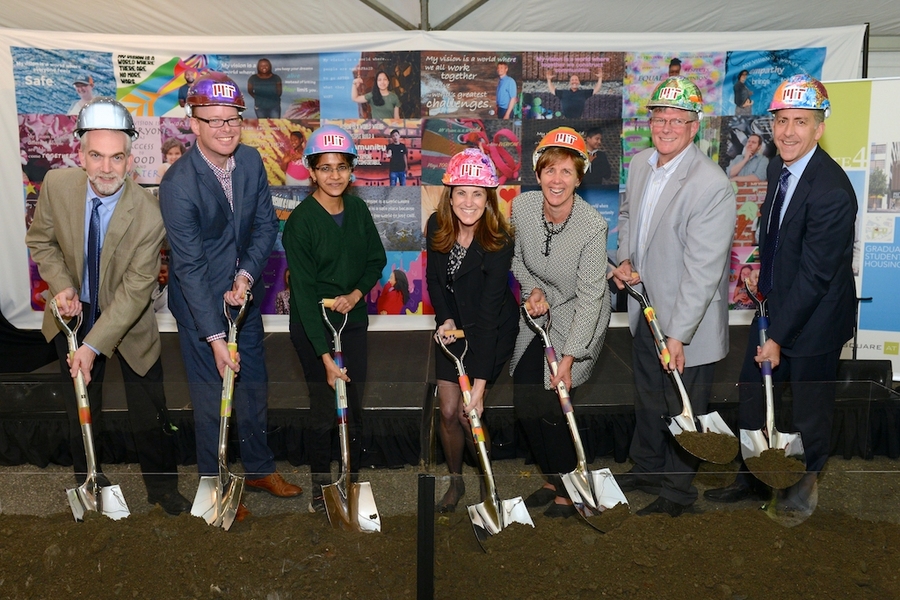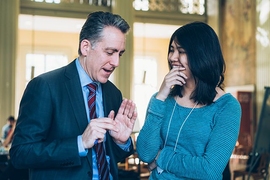In April 2017, MIT Chancellor Cynthia Barnhart appointed Ian A. Waitz as vice chancellor. The former dean of engineering has been in his new post since July, and is responsible for leading and integrating the offices of undergraduate and graduate education. His early priorities include enhancing the first-year student academic experience; improving areas such as advising, professional development, diversity and inclusion, and well-being; and implementing the residential education innovations called for in the Institute-wide Task Force on the Future of MIT Education. Waitz recently spoke about his first few months on the job, progress to date, and future plans.
Q: Let’s start with an issue that’s received a lot of attention as of late: graduate student housing. The chancellor, provost, and executive vice president and treasurer have written to graduate students saying that they will add 950 beds to MIT’s graduate student housing stock and evaluate graduate student housing needs every three years. These developments stem in part from the work that you and the Graduate Student Housing Working Group have been doing since late August. Can you tell us more about this group and the interim assessment you just released?
A: I want to start with a bit of background and context before getting to the interim assessment. As I discovered when I was a dean and department head, space at MIT is at the heart of most things — whether it’s new, old, or to-be-renovated space, and whether it’s for research, teaching, or administration. MIT’s relatively compact footprint along the Charles River, while often challenging, contributes to our culture, deep spirit of collaboration, and close connections with the cities of Cambridge and Boston. Likewise, where students live deeply influences their overall experience here, including their academic experience. In that sense, we must think of MIT not only as an institution, but also as a home for our students while they are here.
I had those realities in mind as the chair of the Graduate Student Housing Working Group. In fact, my office cannot complete part of our charge, enhancing the graduate academic experience, unless we partner with the Division of Student Life to explore issues like housing.
The Graduate Student Housing Working Group is, first and foremost, about research and intelligence-gathering, so we can educate ourselves and the MIT community about the complexities of our current and future housing situation. I have received a crash course over the last six weeks! I also give a lot of credit to the Graduate Student Council and the MIT Graduate Student Apartments Now (GSAN) efforts for accelerating the pace of our efforts, as the formal charge of the group by the chancellor only happened this past August.
As we mention in the interim assessment — which, in many ways, bolsters the prior Clay Report — MIT has been wrestling with the issue for some time now. And we’ve made significant progress. If you include new, renovated, and repurposed residences like Sidney Pacific, the Warehouse, Ashdown, and 70 Amherst, over the last two decades the Institute has invested $700 million providing for 1,470 new beds. In 2020 with the opening the Kendall Square graduate tower there will be an additional 454 beds (about 250 net new beds after Eastgate is closed). We currently house 38 percent of our 6,500 graduate students in MIT housing. Almost 95 percent of new students and 60 percent of continuing students who apply for single grad housing get it, and that rate is about 75 percent for family housing.
However, despite our significant increases in on-campus housing, we have about 1,000 more students living off-campus than two decades ago (now about 4,000 total). The rapid increase in off-campus rental rates is driving up their cost of living. Twenty-three percent of the off-campus students who responded to our survey say they would prefer to live on campus for their entire program, which is double the percentage that responded similarly just four years ago.
The report also provides a lot of new knowledge on what housing attributes our graduate students value. We derived this from a rigorous conjoint analysis, which we pursued on the advice of experts in the Sloan School of Management. We had a general sense of these things in the past, but not in a way that we could quantify them (and understand how they differ among different segments of the population). For example, we learned that in general our graduate students value price, unit type, short commute time, air conditioning, and access to grocery/restaurants most highly. They have a lower willingness to pay for bedroom size, building amenities, sense of community, parking, and fitness centers. When we combine willingness-to-pay for different housing attributes with detailed costing knowledge, we can identify new capacity options that best satisfy student needs while minimizing the financial impacts on MIT.
Q: What have you learned from working so closely with graduate students and where does the working group go from here?
A: While our report offers a lot of data and useful insights, I think the real value is that it strengthens our ongoing partnership with our graduate students. We all have a vested interest in the outcome, but ultimately, they are the folks who will inhabit these spaces.
All of us — administrators and the graduate students on the working group — did this study and learned about its results together, and in turn, shared it with the entire MIT community. I am committed to that kind of transparency for all the issues my office tackles.
In terms of next steps for the working group, we will use the results of the conjoint analysis to build a housing simulator to test different scenarios for fulfilling MITs new commitment to graduate housing capacity. It will be interesting and rewarding for all of us to apply these methods and help shape the future graduate housing landscape at MIT. All members of the MIT community are welcome to offer their comments on the Graduate Student Housing Working Group preliminary recommendations.
I know some were worried that with the integration of the offices of undergraduate and graduate education (now both in the Office of the Vice Chancellor), grad students in particular might lose representation or a seat at the table. That’s not been the case with the housing working group, and it won’t be with any other issue.
Q: What else are you and your office focused on?
A: My office is engaged in a few key priorities right now. We are integrating two existing offices — the Offices of Undergraduate Education and the Office of the Graduate Education, or OUE and OGE — into one (hopefully seamless!) organization that does an even better job supporting our students, faculty, and staff. The aim is to better coordinate student services and functions where we can, and also provide customized, robust support and advocacy for undergraduates and graduates.
As part of that I have held a series of all-hands meetings with staff and students, and it has been a gratifying process. The outputs have been stellar. Staff members have shared their hopes for and fears about the new organization; presented different ways to collaborate; designed potential organizational structures; and defined a fantastic set of collective values, with a strong focus on diversity and inclusion.
While we have a lot more work to do in shaping the organization, we are not standing still.
Already, offices and individuals have stepped up to refresh the first-year undergraduate orientation, with a focus on encouraging students to take advantage of opportunities to explore different majors. With help from faculty from all five MIT schools plus administrators and students, we kicked off an ambitious endeavor to evaluate how to improve the first-year academic experience for undergraduates. In addition, the former dean of OUE, Denny Freeman, is expanding his popular “Mens et Manus” advising seminar. Stay tuned for more details about our plans in the coming weeks.
At the graduate level, in addition to the work on housing, we are focusing on several other issues, including how to provide more professional development opportunities.
While there is a lot to do, I am having a huge amount of fun. It is extremely rewarding work. And the people I have the opportunity to work with are great — especially the students with whom I have gotten to work much more closely in this role.







